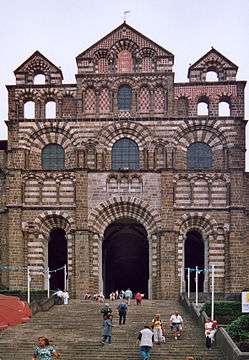Le Puy Cathedral
| Cathedral of Our Lady of the Assumption Cathédrale Notre-Dame-de-l'Annonciation | |
|---|---|
|
Le Puy Cathedral | |
| Basic information | |
| Location | Le Puy-en-Velay, France |
| Geographic coordinates | 45°2′44″N 3°53′5″E / 45.04556°N 3.88472°ECoordinates: 45°2′44″N 3°53′5″E / 45.04556°N 3.88472°E |
| Affiliation | Roman Catholic |
| District | Diocese of Le Puy-en-Velay |
| Ecclesiastical or organizational status | Cathedral-Basilica |
| Architectural description | |
| Architectural type | Church |
| Architectural style | Romanesque |
| Groundbreaking | 11th century |
| Completed | 13th century |
Le Puy Cathedral (Cathédrale Notre-Dame du Puy) is a Roman Catholic cathedral, and a national monument of France, in Le Puy-en-Velay, Auvergne. It has been a centre of pilgrimage in its own right since before the time of Charlemagne, as well as forming part of the pilgrimage route to Santiago de Compostela. Since 1998 it has been a UNESCO World Heritage Site, as part of the "Routes of Santiago de Compostela in France".
It is the seat of the Bishop of Le Puy.
Building description
The cathedral forms the highest point of the city, rising from the foot of the Rocher Corneille, and contains architecture of every period from the 5th century to the 15th, which gives it an individual appearance. The bulk of construction, however, dates from the first half of the 12th century.
Formerly, the visitor passed through a porch standing well out from the building and, after descending beneath the pavement, emerged by a stairway in front of the high altar; the principal stairway is now covered by a bold vaulting which serves as base for one half of the church.

The façade, striped in courses of white sandstone and black volcanic breccia, is reached by a flight of sixty steps, and consists of three orders: the lowest composed of three high arcades opening into the porch, which extends beneath the first bays of the nave; above are three central windows that light the nave; above them are three gables, one the gable-end of the nave, flanked by two openwork screening gables. The south transept doorway is sheltered by a fine Romanesque porch. Behind the choir rises a separate Romanesque bell-tower in seven storeys.
The bays of the nave are roofed by octagonal cupolas, the cupola at the crossing forming a lantern; the choir and transepts are barrel vaulted.
The four galleries of the striking parti-coloured cloister were constructed from the Carolingian period to the 12th century. It is connected to the remains of 13th-century fortifications that separated the cathedral precincts from the rest of the city. Near the cathedral, the 11th-century baptistry of St. John is built on Roman foundations.
Pilgrimage

The cathedral became very early on a centre of the cult of Our Lady and a place of pilgrimage—Charlemagne made the pilgrimage to Le Puy twice—which brought it great wealth and influence. Its treasures escaped the ravages of war repeatedly over the centuries until the French Revolution, when all were destroyed, including the ebony statue of Our Lady of Le Puy which had been a gift of Saint Louis.
Pilgrims starting their journey to Santiago de Compostela gather to be blessed each morning. The cathedral has been a UNESCO World Heritage Site since 1998, as part of the "Routes of Santiago de Compostela in France".
See also
Sources
| Wikimedia Commons has media related to Le Puy Cathedral. |
| Wikimedia Commons has media related to World Heritage Sites of the Routes of Santiago de Compostela in France. |
![]() This article incorporates text from a publication now in the public domain: Herbermann, Charles, ed. (1913). "article name needed". Catholic Encyclopedia. New York: Robert Appleton.
This article incorporates text from a publication now in the public domain: Herbermann, Charles, ed. (1913). "article name needed". Catholic Encyclopedia. New York: Robert Appleton.